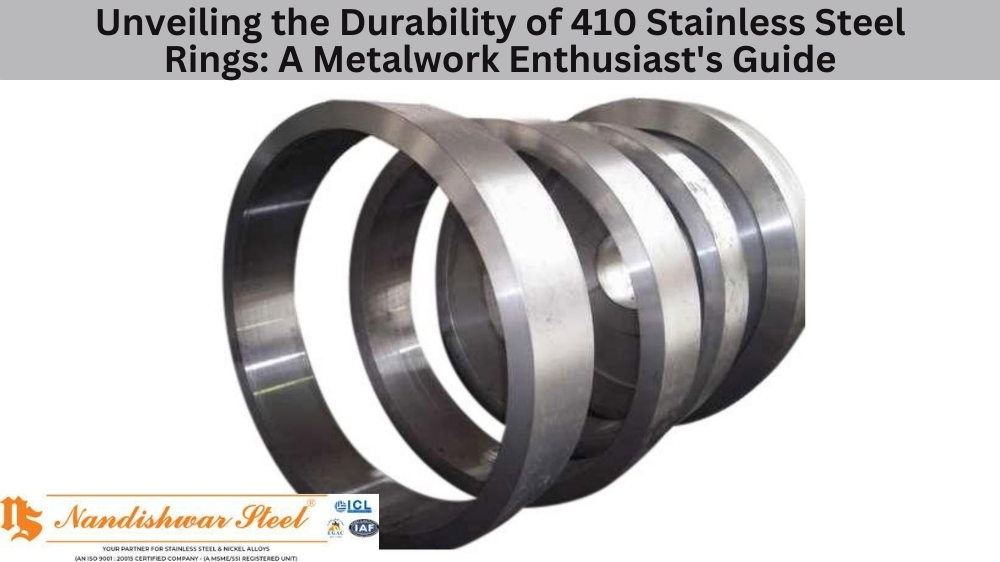Stainless steel’s prowess is unfamiliar to architecture, culinary arts, and jewelry-making. But 410 stainless steel stands out as a material of choice when crafting items that merge beauty with resilience. Predominantly known for its hardening capability after heat treatment, 410 stainless steel offers an ideal blend of strength and corrosion resistance that metalwork enthusiasts can’t help but marvel at.
In this deep dive into the world of 410 stainless steel rings, we’ll explore this robust material’s composition, properties, and versatile uses. Whether you are a seasoned craftsman or a curious novice entranced by the allure of metalworking, this post will provide valuable insights into why 410 stainless steel might be the perfect material for your next project.
The Composition of 410 Stainless Steel
The ‘410’ denomination signifies the subtype of stainless steel that contains a minimum of 11.5% chromium, which is instrumental in forming a protective oxide layer to prevent rust. But what sets 410 apart from other types is its 12% chromium composition balanced with low carbon content. This unique chemical makeup empowers it with enhanced wear resistance and hardness.
Mechanical Properties and Hardness
For artisans and metalwork specialists, understanding the mechanical properties of 410 stainless steel is crucial. On the Rockwell scale, it scores an impressive HRC (Rockwell Hardness) of up to 42 when heat-treated, pointing towards hard-wearing characteristics. Rings crafted from this metal are heralded for their durability and are likely to withstand the everyday wear and tear that softer metals cannot.
Heat Treatment and Machinability
One of the compelling reasons to choose 410 stainless steel is its heat treatment responsiveness. The metal can be tempered to achieve a desired level of hardness by undergoing a series of heating and cooling processes, making it pliable enough to shape into intricate ring designs yet tough enough to resist scratches and dents.
While its machinability in the annealed condition is generally fair, it can become brittle with extensive machining after hardening. Thus, working with 410 requires carefully balancing forming and finishing techniques to achieve the best results.
Corrosion Resistance—Balancing Pros and Cons
The corrosion resistance of 410 rings is not as high as that of austenitic or ferritic stainless steels, but with proper maintenance, it protects against the oxidizing atmosphere. However, it’s less resistant to corrosive environments, so it’s not recommended for high-humidity or marine applications without a protective coating or frequent care.
Versatile Applications Beyond Metalwork
Outside of the metalwork shop, 410 stainless steel rings serve various functions. They’re popular in automotive, petrochemical, and engineering due to their thermal conductivity and strength at elevated temperatures. Its aesthetic appeal and tough exterior make it a compelling choice for fashion jewels.
Maintenance Tips for Longevity
Maintaining a 410 stainless steel ring isn’t relatively inexpensive. Regular cleaning with mild soap and water followed by a thorough drying is sufficient to maintain its lustre. For metalwork projects, routine maintenance depends on the environment; in mild conditions, a periodic wipe-down may suffice, while in harsher conditions, proactive care is essential.
Conclusion
For those intrigued by the confluence of artistry and metallurgy, 410 stainless steel rings offer a delightful challenge and a reward for durability and strength. It’s a testimony to the architectural genius that can withstand the test of time and usage. Whether you are creating ornate jewellery, crafting durable hardware, or looking for materials with robustness and aesthetic appeal, 410 stainless steel emerges as a shining contender. For metalwork enthusiasts, dabbling with 410 stainless steel rings isn’t just a testament to skill—it’s an ode to the timeless appeal of combining form and function. So, as we forge ahead in our metalwork pursuits, let’s pay homage to the hearty resilience of 410 stainless steel—the silent stalwart that beautifies our workbenches and wardrobes.
Remember, while 410 may not have the corrosion resistance of its austenitic brothers, its blend of features makes it a reliable player in metallurgy. For your next project, consider employing this formidable alloy, and watch as it transforms under the craftsman’s touch, embodying both the robust spirit and the delicate precision of your work. If you’re smitten by the allure of 410 stainless steel and its capabilities, the journey of crafting with this metal is sure to be as gratifying as the result.



